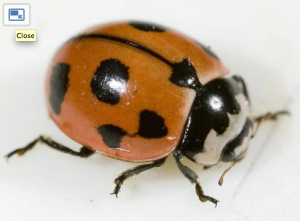
Once extremely common in New York, the nine-spotted became rare over the last 40 years and was even thought to be extinct, said Leslie Allee, a Cornell entomologist.
Allee and another Cornell entomologist, John Losey, formed the Lost Ladybug Project in 2000 to investigate why the nine-spotted and two other ladybug species that were once common in North America had become so rare so fast.
Ladybugs may have an adorable name and look pretty cute, but they also have an important job to do: They eat other insects.
"If we didn't have ladybugs we would need to use much higher levels of pesticides," Allee said. "So not only are they saving us money and saving crops, but they are also contributing to human health by reducing the level of pesticides that are needed."
Combining research with citizen science, the project uses photos and actual ladybugs submitted by people across the country to map where certain ladybug species are found, study differences between them and breed them. So far, 13,370 photos of ladybugs have been contributed by people around the country and Canada.
But no contribution was more significant than last July when project volunteer Peter Priolo organized a group search in Amagansett on Long Island, N.Y. Priolo spotted a nine-spot in a patch of sunflowers on an organic farm. It was the first one found in New York in 30 years and just the second found on the East Coast in the last 40 years, Allee said.
"This completely shifted our research data because it wasn't just one, it was a nice-sized population," Allee said.
Members of the lab in Ithaca headed to Amagansett to collect a bunch of the ladybugs. Now, there are about 100 nine-spotted ladybugs living in plastic containers in the lab. With a steady diet of aphids, housed in a climate-controlled room connected to the lab, the population should grow by 25 percent every three to four weeks. Along with Allee and Losey, undergraduate and graduate students work in the lab feeding the ladybugs, collecting data and cleaning the plastic homes.
So far, research from the project has yielded three different theories on the disappearance of the nine-spotted ladybugs: competition with invasive species of ladybugs; hybridization; and changes to the environment, such as climate change.
On hybridization, for example, the lab is looking at if it is possible that the nine-spotted could have interbred with the seven-spotted and essentially bred itself out of existence.
The conditions in the lab are better than in nature, Allee said, as the temperature is regulated, food is given regularly and there are no predators around. Though the project is about five to 10 years away from reintroducing the bug back into the environment, that remains a possibility, Allee said.
In addition to the research, a significant part of the Lost Ladybug Project is about outreach to community members, said Rebecca Smyth, who corresponds with the people who submit photos. Smyth can only remember one day last year when she did not receive a photograph.
"I saw there were no submissions and I thought, 'can this be true?'" she said. "But then I thought, 'Well it is Christmas, so that is OK."
